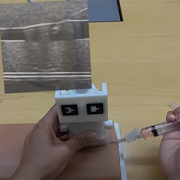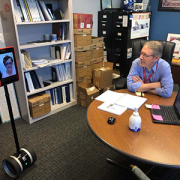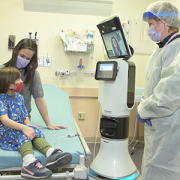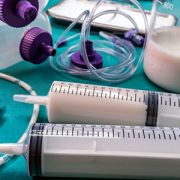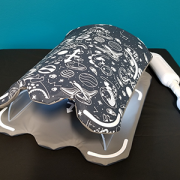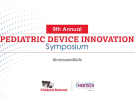New platform uses augmented reality glasses for ultrasound-guided procedures
Children’s National experts developed a novel visualization platform, called “HoloUS,” for ultrasound-guided procedures using commercially available see-through augmented reality (AR) glasses, according to a pre-clinical study published in the International Journal of Computer Assisted Radiology and Surgery. The finding suggests that the HoloUS application enhanced the user experience and simplified hand-eye coordination.
“By eliminating head-turning and back-and-forth viewing of the patient and the ultrasound screen, our solution could improve the safety, accuracy, intuitiveness, and length of ultrasound-guided procedures, while making them easier to learn and perform,” said Raj Shekhar, M.S., Ph.D., principal investigator for Sheikh Zayed Institute for Pediatric Surgical Innovation at Children’s National and senior author in the study.
Ultrasound-guided procedures demand a high degree of hand-eye coordination to advance a needle with one hand while holding the ultrasound probe with another as they visualize the live ultrasound image. With this application, the practitioner will wear the AR glasses that will allow them to visualize the ultrasound image rendered live in their field of view.
“We are excited about the possibility of improving the accuracy and efficiency from augmented reality visualization because these benefits may translate clinically in the upcoming years after conducting carefully designed clinical studies,” said Trong Nguyen, staff scientist for Sheikh Zayed Institute for Pediatric Surgical Innovation at Children’s National and lead author.
Microsoft’s HoloLense headset, often used for hands-free work and video gaming, set the stage to develop the custom application that would display information from a portable ultrasound machine connected through a wireless network in the form of a hologram. The voice controls on the HoloLense allowed scaling and movement of the ultrasound imaging while displaying in real-time.
Largely driven by video gaming and consumer applications, AR and virtual reality technologies have been growing and are expected to grow at an even faster clip in the coming decade.
“We are a handful of researchers exploring the innovative application of the technology for ultrasound visualization,” said Shekhar. “We are trying to establish ourselves as the leader in the use of AR for pediatric ultrasound procedures.”
To further advance this technology, Shekhar’s team has an IRB protocol pending that will continue to shed light on the benefits through more bench testing and an NIH grant proposal that is also pending. In the meantime, they will adopt second-generation glasses to continue to improve the technology.


